Success Stories
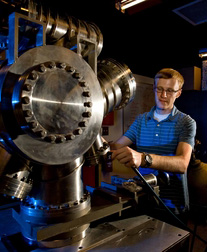 |
Michael Christiansen graduated ASU with a BS in Physics in the spring of 2012. His Space Grant internship was on the physics of nanoscale systems, under Dr. Jeffrey Drucker on a project exploring the use of silver nanocrystals to enhance the interaction of silicon/germanium quantum dots with light. Quantum dots and nanowires are both types of nanostructures, tiny arrangements of atoms that have at least one dimension on the scale of nanometers. Michael has also done fieldwork for the Denver Museum of Nature and Science as a paleontology intern, interned with the Department of Energy at the National Renewable Energy Laboratory, been awarded a Goldwater Scholarship as well as the John and Richard Jacob Award which was based on research with Dr. Drucker. He is now pursuing a PhD in Materials Science and Engineering at Massachusetts Institute of Technology. In the News: From Fossils to Nanoresearch, Student Pursues Scientific Chase |
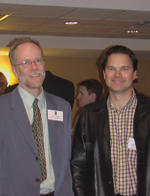 |
Shea Ferring graduated from ASU in December of 1998 with a MSE in Aerospace Engineering. Shea Ferring was involved with ASU NASA Space Grant first as Structures Team Lead for ASUSat1 during his Space Grant Internship (1994-1996), and then as Program Manager during his Space Grant Fellowship (1996-1999). During his fellowship he acted as Lead Robot Design Mentor for the US FIRST Robotics for two local high schools. The teams won the Florida Regional Champion, Florida Rookie All Star, and placed top 20 worldwide in competition with over 1500 teams. Shea supported NASA Expendable Launch Vehicles (ELV) missions as an engineering manager at Kennedy Space Center, Florida and managed over 100 engineers in support of every NASA ELV mission (about 8 launches per year) to ensure each vehicle is properly designed, built, tested, and ready for launch. His work has included missions such as the Mars Reconnaissance Orbiter, the Mars Exploration Rovers and the SIRTF Space Telescope. Shea's background covers NASA, military and commercial space programs and his experience in systems engineering ranges from nano-to-large spacecraft and the entire active US fleet of Expendable Space Launch Vehicles. Shea currently works at Orbital Sciences Corporation in Chandler, AZ as a Propulsion Engineer Manager. |
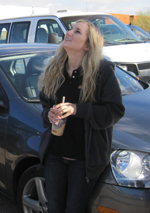 |
Hallie Gengl graduated ASU in the spring of 2012 with a BS in Earth and Space Exploration and a minor in Climatology. Her Space Grant internship was under the mentorship of Dr. Mark Robinson at the Lunar Reconnaissance Orbiter Camera Science Operations Center studying bouldery, raised rim mare craters on the lunar surface that are seen in LROC Narrow Angle Camera (NAC) images. Hallie was also involved with Space Grant’s high altitude balloon payload project, ASCEND (Aerospace Scholarships to Challenge and Educate New Discoverers). She was the Vice President and co-founder of the Students for the Exploration of Space at Arizona State University (SEDS-ASU) and was the Director of National Expansion on the Executive National Board for SEDS-USA. In addition, she was awarded a summer internship at NASA Jet Propulsion Laboratory working on the Mars Science Lab landing site. Through her Space Grant and JPL internships, she was able to secure a career with the Jet Propulsion Laboratory (JPL) where she is now working as a Mission Operations Engineer in the Mars Science Laboratory. |
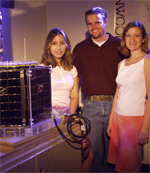 |
Erik Henrikson began attending ASU in the summer of 2001 as an undergraduate transfer student, and began volunteering on the satellite team that fall. In a matter of a couple months he found himself as a full intern on the NASA Space Grant program working as the integration and test lead for a project called Three Corner Sat (3CS) which was delivered to Air Force Research Labs (AFRL) in February of 2002. After delivery, he spent a lot of time traveling out to AFRL and working with the engineers there to test and integrate spacecraft to other pieces of hardware that were going to fly. He also had the opportunity to present in front of the NASA safety review board at Johnson Space Center in Houston, Texas in the fall of 2002. He finished his time as the student program manager of 3CS in December, 2004, with the launch of 3CS aboard the Delta IV Heavy Rocket Demo mission. He also spent summers at Jet Propulsion Laboratory (JPL) in Pasadena, CA in 2003 and AFRL on Albuquerque, NM in 2004, working on other projects. While at JPL, he worked on a mission concept for a constellation of satellites to perform atmospheric science while orbiting Mars. He served as the altitude determination and control engineer for that project. During his time at AFRL he performed research on small satellite standards and an initial standardized satellite bus design. |
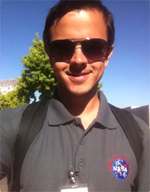 |
Eric Hinkson graduated ASU at the Polytechnic campus with a BS in Electronics Engineering Technology with a concentration in alternative energies. His internship consisted of working in the Alternative Energies Laboratory underneath Dr. Arunachalanadar Madakannan, focusing on fuel cell design. Eric was awarded a summer internship at NASA Ames on a project using living organisms and in-situ resources to create a “bio-cement” for use in constructing shelters in harsh environments, such as the Moon or Mars. Eric has also been awarded a scholarship from the Department of Defense, denoted the SMART Scholar program and was an author on a scientific paper involving hydrogen polymer electrolyte membrane fuel cells spring 2012. He is currently a Systems Engineer for the US Dept of the Army. |
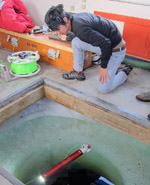 |
Colin Ho graduated ASU with a BS Mechanical Engineering in the spring of 2012. He was project manager for the Micro Submersible Lake Exploration Device (MSLED) being developed in the Extreme Environment Robotics and Instrumentation Lab under Dr. Alberto Behar. Colin was part of the MSLED team that recently traveled to Antarctica to test the MSLED prototype under the sea ice in McMurdo Sound. They were able to demonstrate full user control and instrument data feedback as well as take video of the abundant sealife. Colin was also working on autonomous underwater vehicles with Dr. Srikanth Saripalli where he researches using robotic underwater vehicles to conduct environmental sensing. He was also awarded a summer internship at NASA's Jet Propulsion Laboratory where he worked to develop the initial design for a miniature submarine that will be used to explore sub-glacial lakes in Antarctica. Colin has recently been working on several projects through companies which he has co-founded. His other plans include attending Carnegie Mellon University for Robotics. In the News: Undergraduate Researcher's Work Destined for the Deep |
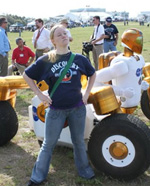 |
Emily McBryan is a senior at ASU double-majoring in aerospace engineering and systems engineering. During her internship she acted as team lead for the ASU/NASA Space Grant Robotics team was also been a Space Grant student advisor for 3 years. Before getting involved with the ASU/NASA Space Grant program, McBryan got involved at her high school’s robotics team, which was a part of the For Inspiration and Recognition of Science Technology (FIRST) team that her sister initiated. Her dad encouraged her and worked with her during high school. During the spring of 2011, she traveled to NASA's Johnson Space Center (JSC) in Houston to work with Robonaut 2 (R2), the groundbreaking robot that can perform both routine and dangerous tasks in space.She came up with three new mechanical designs for Robonaut's finger actuators, which provide mobility and strength for R2's hands. She also traveled to Kennedy Space Flight Center with the R2 team to take part in the launch of R2 on STS-133. In the News: ASU Student Lends Robonaut 2 a Hand | Leading the Dream Machine |
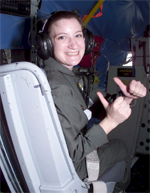 |
Lisa Tidwell started college at ASU in 1997 and immediately joined the NASA Space Grant Program as an intern. As part of the ASU Student Satellite team, she worked on two satellites. She also helped build moon buggies and designed an experiment that flew on NASA's Weightless Wonder, the NASA KC-135 zero gravity plane. After graduating from ASU in Aerospace Engineering in 2002, she worked in the Public Affairs Office at the Johnson Space Center (JSC). While at JSC she wrote for the Roundup, the JSC newspaper, created a presentation about the similarities of the International Space Station and the home or office, and visited all types of great places at the Center. In 2003, She chose to return to ASU for graduate school and was awarded a NASA Space Grant fellowship leading a team of communication students to win the National Grand Prize in the NASA Means Business Competition. She received her master's in Mass Communication in December 2004. At 21-years-old, items she built with her hands were flying in space, at 23-years-old she was working with Astronauts and the White House Press Corp at NASA. She has also worked with the Phoenix Mars Lander. |
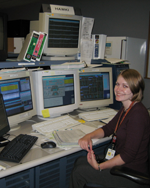 |
Melissa Wallace graduated in May of 2004 with a degree in Aerospace Engineering. During her time at ASU, she was involved in many of the projects sponsored by ASU/NASA Space Grant. She was a team member of the High-speed Autonomous Rotocraft Vehicle as well as the Moon Devils Moon Buggy team. She was Moon Buggy's co-lead in 2003, when the Moon Devils swept the awards ceremony, winning the Best Engineering Design (awarded by AIAA) and Best Pit Crew. In 2003, she led a team of four students in writing and submitting a proposal to the NASA Reduced Gravity Student Flight Opportunities Program. Their propposal investigating the effects of reduced gravity on the electrical activity of the brain was accepted and in summer of 2003, the students flew their experiment on the NASA KC-135 aircraft, known as the Vomit Comet. Also in 2003, Melissa was Deputy Project Manager of the mARZSat program, a microsatellite program in conjunction with the Jet Propulsion Laboratory (JPL) in Pasadena, CA. The goal of the project was to design and build a microsatellite to take high resolution images of Mars. In the summer of 2003, Melissa was selected for the Summer Undergraduate Research Fellowshhip (SURF program) offered by CalTech at JPL and participated in the design of a constellation of microsatellites to research the atmosphere of Mars. In the 2003-2004 school year, Melissa was the Program Manager of MIMIC: Magnetic field Investigation of Mars by Interacting Consortia. This project was in conjunction with JPL and involved ten universities across country working to design and build a microsatellite to measure the remnant magnetic fields of Mars. |
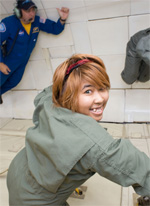 |
Pye Pye Zaw is a senior majoring in Earth and Space Exploration at ASU. Her space grant internship is with Dr. Mark Robinson at Lunar Reconnaissance Orbiter Camera Science Operations Center. This summer she worked on Apollo data restoration and now she is working with LROC images to study efficiency of space optical systems through image analysis. She also led Dust Devils Microgravity Team. She was an intern at NASA Ames for the National Lunar Science Institute and worked as a project's assistant for the National Optical Astronomy Observatory during the summer of 2011. She has also worked on education outreach for the ASU Lunabotics Team, She is one of the founding members of ASU AstroDevils: Astronomy Club, and she is on the SEDS-USA National Board as a High School Affairs Representative. She is also working on optical systems as a member of ASCEND! In the News: Adventures in Micorgravity: Students Experiment in Simulated Space-flight Conditions |



